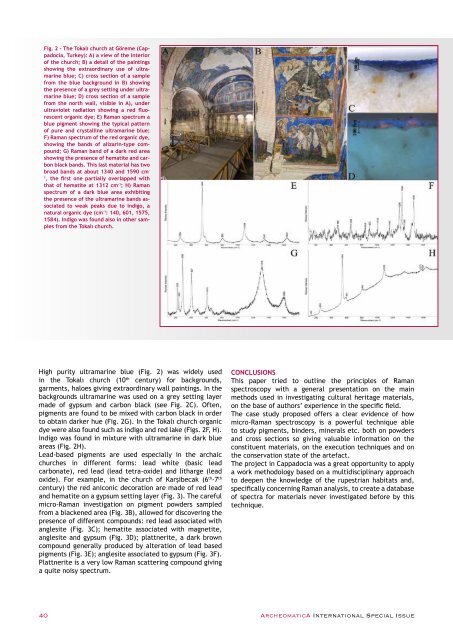Archeomatica International 2017
Special supplement to Archeomatica 3 2017
Special supplement to Archeomatica 3 2017
You also want an ePaper? Increase the reach of your titles
YUMPU automatically turns print PDFs into web optimized ePapers that Google loves.
Fig. 2 - The Tokalı church at Göreme (Cappadocia,<br />
Turkey): A) a view of the interior<br />
of the church; B) a detail of the paintings<br />
showing the extraordinary use of ultramarine<br />
blue; C) cross section of a sample<br />
from the blue background in B) showing<br />
the presence of a grey setting under ultramarine<br />
blue; D) cross section of a sample<br />
from the north wall, visible in A), under<br />
ultraviolet radiation showing a red fluorescent<br />
organic dye; E) Raman spectrum a<br />
blue pigment showing the typical pattern<br />
of pure and crystalline ultramarine blue;<br />
F) Raman spectrum of the red organic dye,<br />
showing the bands of alizarin-type compound;<br />
G) Raman band of a dark red area<br />
showing the presence of hematite and carbon<br />
black bands. This last material has two<br />
broad bands at about 1340 and 1590 cm -<br />
1<br />
, the first one partially overlapped with<br />
that of hematite at 1312 cm -1 ; H) Raman<br />
spectrum of a dark blue area exhibiting<br />
the presence of the ultramarine bands associated<br />
to weak peaks due to indigo, a<br />
natural organic dye (cm -1 : 140, 601, 1575,<br />
1584). Indigo was found also in other samples<br />
from the Tokalı church.<br />
High purity ultramarine blue (Fig. 2) was widely used<br />
in the Tokalı church (10 th century) for backgrounds,<br />
garments, haloes giving extraordinary wall paintings. In the<br />
backgrounds ultramarine was used on a grey setting layer<br />
made of gypsum and carbon black (see Fig. 2C). Often,<br />
pigments are found to be mixed with carbon black in order<br />
to obtain darker hue (Fig. 2G). In the Tokalı church organic<br />
dye were also found such as indigo and red lake (Figs. 2F, H).<br />
Indigo was found in mixture with ultramarine in dark blue<br />
areas (Fig. 2H).<br />
Lead-based pigments are used especially in the archaic<br />
churches in different forms: lead white (basic lead<br />
carbonate), red lead (lead tetra-oxide) and litharge (lead<br />
oxide). For example, in the church of Karşibecak (6 th -7 th<br />
century) the red aniconic decoration are made of red lead<br />
and hematite on a gypsum setting layer (Fig. 3). The careful<br />
micro-Raman investigation on pigment powders sampled<br />
from a blackened area (Fig. 3B), allowed for discovering the<br />
presence of different compounds: red lead associated with<br />
anglesite (Fig. 3C); hematite associated with magnetite,<br />
anglesite and gypsum (Fig. 3D); plattnerite, a dark brown<br />
compound generally produced by alteration of lead based<br />
pigments (Fig. 3E); anglesite associated to gypsum (Fig. 3F).<br />
Plattnerite is a very low Raman scattering compound giving<br />
a quite noisy spectrum.<br />
CONCLUSIONS<br />
This paper tried to outline the principles of Raman<br />
spectroscopy with a general presentation on the main<br />
methods used in investigating cultural heritage materials,<br />
on the base of authors’ experience in the specific field.<br />
The case study proposed offers a clear evidence of how<br />
micro-Raman spectroscopy is a powerful technique able<br />
to study pigments, binders, minerals etc. both on powders<br />
and cross sections so giving valuable information on the<br />
constituent materials, on the execution techniques and on<br />
the conservation state of the artefact.<br />
The project in Cappadocia was a great opportunity to apply<br />
a work methodology based on a multidisciplinary approach<br />
to deepen the knowledge of the rupestrian habitats and,<br />
specifically concerning Raman analysis, to create a database<br />
of spectra for materials never investigated before by this<br />
technique.<br />
40 ArcheomaticA <strong>International</strong> Special Issue


















